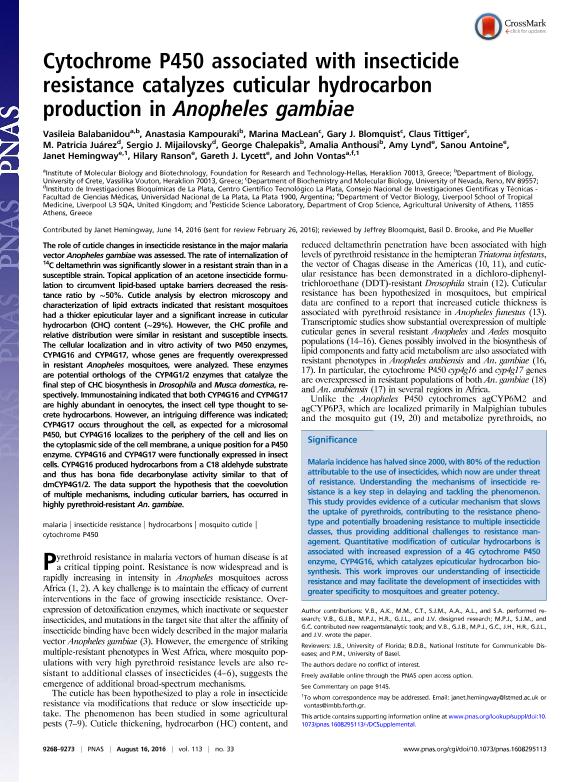Artículo
Cytochrome P450associated with insecticide resistance catalyzes cuticular hydrocarbon production in Anopheles gambiae.
Balabanidou, Vasileia; Kampouraki, Anastasia; Mac Lean, Marina; Blomquist, Gary J.; Tittiger, Claus; Juarez, Marta Patricia ; Mijailovsky, Sergio Javier
; Mijailovsky, Sergio Javier ; Chalepakis, George; Anthousi, Amalia; Lynd, Amy; Antoine, Sanou; Hemingway, Janet; Ranson, Hilary; Lycett, Gareth J.; Vontas, John
; Chalepakis, George; Anthousi, Amalia; Lynd, Amy; Antoine, Sanou; Hemingway, Janet; Ranson, Hilary; Lycett, Gareth J.; Vontas, John
 ; Mijailovsky, Sergio Javier
; Mijailovsky, Sergio Javier ; Chalepakis, George; Anthousi, Amalia; Lynd, Amy; Antoine, Sanou; Hemingway, Janet; Ranson, Hilary; Lycett, Gareth J.; Vontas, John
; Chalepakis, George; Anthousi, Amalia; Lynd, Amy; Antoine, Sanou; Hemingway, Janet; Ranson, Hilary; Lycett, Gareth J.; Vontas, John
Fecha de publicación:
07/2016
Editorial:
National Academy of Sciences
Revista:
Proceedings of the National Academy of Sciences of The United States of America
ISSN:
0027-8424
Idioma:
Inglés
Tipo de recurso:
Artículo publicado
Clasificación temática:
Resumen
The role of cuticle changes in insecticide resistance in the major malaria vector Anopheles gambiae was assessed. The rate of internalization of 14C deltamethrin was significantly slower in a resistant strain than in a susceptible strain. Topical application of an acetone insecticide formulation to circumvent lipid-based uptake barriers decreased the resistance ratio by ∼50%. Cuticle analysis by electron microscopy and characterization of lipid extracts indicated that resistant mosquitoes had a thicker epicuticular layer and a significant increase in cuticular hydrocarbon (CHC) content (∼29%). However, the CHC profile and relative distribution were similar in resistant and susceptible insects. The cellular localization and in vitro activity of two P450 enzymes, CYP4G16 and CYP4G17, whose genes are frequently overexpressed in resistant Anopheles mosquitoes, were analyzed. These enzymes are potential orthologs of the CYP4G1/2 enzymes that catalyze the final step of CHC biosynthesis in Drosophila and Musca domestica, respectively. Immunostaining indicated that both CYP4G16 and CYP4G17 are highly abundant in oenocytes, the insect cell type thought to secrete hydrocarbons. However, an intriguing difference was indicated; CYP4G17 occurs throughout the cell, as expected for a microsomal P450, but CYP4G16 localizes to the periphery of the cell and lies on the cytoplasmic side of the cell membrane, a unique position for a P450 enzyme. CYP4G16 and CYP4G17 were functionally expressed in insect cells. CYP4G16 produced hydrocarbons from a C18 aldehyde substrate and thus has bona fide decarbonylase activity similar to that of dmCYP4G1/2. The data support the hypothesis that the coevolution of multiple mechanisms, including cuticular barriers, has occurred in highly pyrethroid-resistant An. gambiae.
Palabras clave:
Malaria
,
Insecticide Resistance
,
Hydrocarbons
,
Mosquito Cuticle
Archivos asociados
Licencia
Identificadores
Colecciones
Articulos(INIBIOLP)
Articulos de INST.DE INVEST.BIOQUIMICAS DE LA PLATA
Articulos de INST.DE INVEST.BIOQUIMICAS DE LA PLATA
Citación
Balabanidou, Vasileia ; Kampouraki, Anastasia; Mac Lean, Marina; Blomquist, Gary J. ; Tittiger, Claus; et al.; Cytochrome P450associated with insecticide resistance catalyzes cuticular hydrocarbon production in Anopheles gambiae.; National Academy of Sciences; Proceedings of the National Academy of Sciences of The United States of America; 113; 33; 7-2016; 9268-9273
Compartir
Altmétricas



